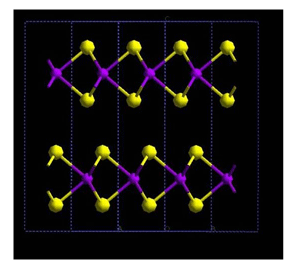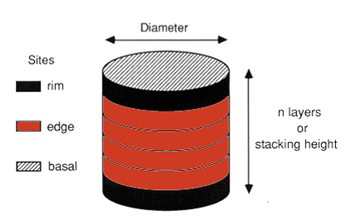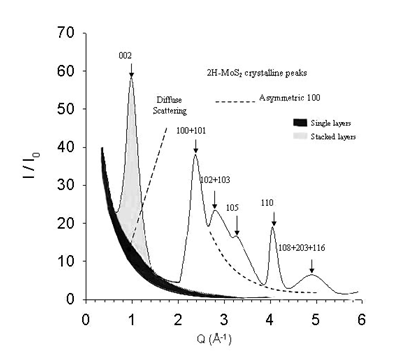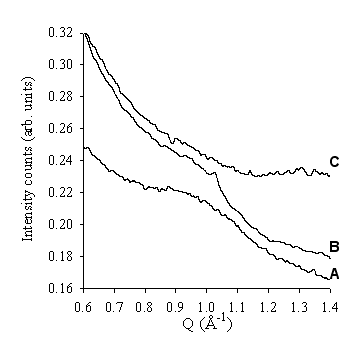
As the world economy continues to expand the demand for petroleum based fuel increases and the price of these fuels rises. The rising price of fuel has another consequence: refiners tend to purchase cheaper fuels of poorer quality. These poor quality fuels contain increasing amounts of sulfur and other pollutants leading to a decline in air quality worldwide. A recent New York Times article described the major impact a growing Chinese economy will have on sulfur pollution causing an increase in acid rain and smog across the world.
Hydrodesulfurization (HDS) is a vital process to alleviate environmental effects, where the incoming petroleum feedstock is treated with hydrogen to remove sulfur from the petroleum as H2S. Transition Metal Sulfide (TMS) catalytic materials, especially Molybdenum disulfide (MoS2) and promoted Co(Ni)/MoS2 catalysts normally supported on alumina (Al2O3), are very good at removing sulfur from petroleum. Nevertheless, obtaining structural information about the changes of the metal/support interface is difficult because MoS2 has a highly anisotropic layered stacked structure (Figure 1).

Active MoS2 catalysts occur in stacks of four to five layers, when freshly prepared. A popular model of the reactivity of these catalyst, the "edge and rim" model, considers the differential reactivity of different exposed planes towards reactants. Basal planes are thought to be inert while edge planes are known to be reactive. The stack height of a MoS2 slabs of a given diameter influences selectivity by varying the ratio of rim sites (active in hydrogenation and C-S bond rupture) to edge sites (active only in C-S rupture) (Figure 2)1. However, there have always been some doubts on the applicability of the "edge and rim" model to Co and Ni promoted MoS2 catalysts used in industrial HDS process, as the initial model was developed for a simple "unpromoted" MoS2 system. The work reported here is the first attempt to determine the catalytically stable state of a HDS catalyst after 4 years of use in an industrial reactor. The knowledge of the CSS of any catalysts forms the basis for an understanding of its reactivity and the mechanisms for its eventual aging and demise.

Often transmission electron microscopy (TEM) is used to visualize the catalyst morphology. However, ability to see poorly crystalline MoS2 slabs, in TEM, strongly depends on how the slabs are bonded to the support. Edge-bonded layers are clearly visible, whereas flat thin slabs are often missed. Another alternative is to probe the structure via EXAFS/XAFS. However, due to the elimination of low k data in EXAFS analysis and the highly disordered nature of the MoS2 slab, EXAFS/XAFS is not very useful in probing medium range order and thus the morphology of MoS2 slabs. X-ray diffraction pattern is the fourier transform of a material in reciprocal space. Further, diffraction patterns are easy to measure between Q of 0.1 — 10 A-1 (d- spacing of 0.6 to 60 A). Further a x-ray diffraction pattern probes all orientations of the MoS2 slabs, albeit as a fourier transform of the real space morphology, and thus gives an unbiased picture of the catalyst morphology. Therefore, x-ray diffraction appears to be the ideal probe for the determination of the CSS of promoted MoS2 catalyst. Never the less, because of the poor crystallinity of the MoS2 slabs, the overall diffraction signal is weak and the alumina support contributes significantly to the overall diffraction and therefore conventional lab based diffractometers have failed.
In this work, every effort was made to reduce the background of the diffraction pattern, by using " zero " background sample holders, a high brightness x-ray source, and tightly aligned beam collimators. The contributions of the Al2O3 were eliminated by carefully measuring the diffraction from support alone and then subtracting it from the supported catalyst diffraction pattern by employing the appropriate normalizations. The resulting patterns after subtraction resembled those found for the poorly crystalline unsupported MoS2 phase, therefore validating the subtraction procedure.

Liang and coworkers2 have established a procedure for quantitatively determining the size of the MoS2 slabs from the analysis of the width of the diffraction peaks. Their procedure was followed to determine the average height and the diameter of the MoS2 slab from the width of the (002) and (110) peaks. Liang et al.'s line broadening analysis was complemented by a full scattering model. The full scattering model evaluates the area of the 002 peak and the diffuse scattering area under the 002 peak to determine the fractions of stacked and unstacked layers. The resulting areas of the (002) peak and the diffuse area under the peak correspond to the respective contributions of stacked and unstacked layers of the commercial catalysts. The relative proportions of stacked and unstacked layers were then directly obtained from the XRD data (see figure 3)3 . This approach allows identification of significant features of the diffraction pattern.
After four years of industrial hydrotreating operations synchrotron scattering patterns of these catalysts show that the catalytic material is on average composed of 7nm diameter slabs. The determination of the average diameter of the MoS2 is in very good agreement with statistically average sizes obtained from HRTEM photographs of several MoS2 slabs. The very surprising result is that a very large fraction of these MoS2 slabs are completely de-stacked3 (see figure 4). The high pressure applied during the hydrotreating conditions and the strong interaction of adsorbed substances (in this case, hydrocarbon molecules), we believe, provides the stabilization of single MoS2 layers and is the main cause for the destacking process observed in commercial catalysts under industrial conditions. Similar pressure-crystallization effect, of decreasing stacking with increasing pressure, inside the reactor during the hydrothermal synthesis of MoS2 in an autoclave have been reported by Peng et al4. The de-stacking of the MoS2 slabs, according to the "edge and rim" model, should result in significant decrease in activity since the de-stacked slabs have much lower proportion of Mo active edge sites. However, the activity of the commercial catalysts changed insignificantly over 4 years in a commercial reactor and the process of almost complete de-stacking.

The result is highly significant not only because for the first time a clear picture of the catalytically stabilized MoS2 phase is described, but also because it calls into question previous models based on fresh MoS2 catalyst. The newly determined catalytically stabilized MoS2 phase structure appears to indicate that the activity/selectivity of a promoted catalyst is related to the size but not to the height of the MoS2 slab. Therefore, it appears that the promoter cations, such as Co or Ni, tend to reduce the difference between the reactivity of the edge and the rim sites, perhaps by preferentially enhancing the reactivity of the edge sites. This insight suggests pathways to making improved catalysts to address the sulfur pollution problem.
Acknowledgement: Portions of this research were carried out at the Stanford Synchrotron Radiation Laboratory, a national user facility operated by Stanford University on behalf of the U.S. Department of Energy, Office of Basic Energy Sciences. The wonderful staff at the SSRL is gratefully acknowledged. We would like to thank for their financial support the U.S. Department of Energy Gateway Program and the Robert A. Welch Foundation. The authors would thank for their help A. Camacho and M.J. Yacaman from the University of Texas at Austin for performing HRTEM analysis of some of our samples. They would like also to thank for their help S. Fuentes from the "Centro de Ciencias de la Materia Condensada", Ensenada, Mexico and for providing commercial catalysts, J. Ascension Montoya and F. Murrieta from IMP.
- Daage M., Chianelli R.R., J. Catal. 149 (1994) 414.
- Liang K.S., Chianelli R.R., Chien F.Z., Moss S.C., J. Non-Cryst. Solids 79 (1986) 251.
- Perez De la Rosa M., Texier S., Berhault G., Camacho A., Yacaman M.J., Mehta A., Fuentes S., Montoya J.A., Murrieta F., Chianelli R.R., :J. Catal. 225 (2004) 288.
- Peng Y., Meng Z., Zhong C., Lu J., Yu W., Yang Z., Qian Y., J. Solid State Chem. 159 (2001) 170.
M. Perez De la Rosa, S. Texier, G. Berhault, A. Camacho, M. J. Yacaman, A. Mehta, S. Fuentes, J. A. Montoya, F. Murrieta and R. R Chianelli, "Structural Studies of Catalytically Stabilized Model and Industrial-supported Hydrodesulfurization Catalysts", J. Catal. 225, 288 (2004)




